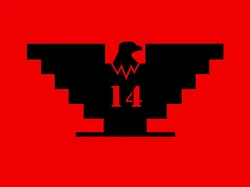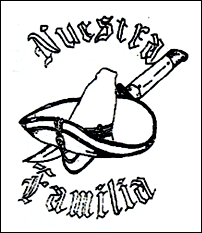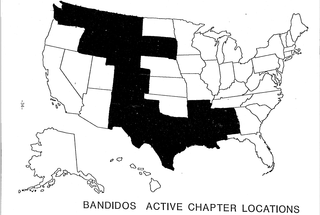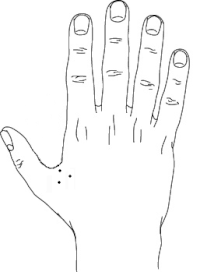A gang is a group or society of associates, friends, or members of a family with a defined leadership and internal organization that identifies with or claims control over territory in a community and engages, either individually or collectively, in illegal, and possibly violent, behavior, with such behavior often constituting a form of organized crime.

The Bandidos Motorcycle Club, also known as the Bandido Nation, is an outlaw motorcycle club with a worldwide membership. Formed in San Leon, Texas, in 1966, the Bandidos MC is estimated to have between 2,000 and 2,500 members and 303 chapters located in 22 countries, making it the second-largest motorcycle club in the world behind the Hells Angels.
A gangster is a criminal who is a member of a gang. Most gangs are considered to be part of organized crime. Gangsters are also called mobsters, a term derived from mob and the suffix -ster. Gangs provide a level of organization and resources that support much larger and more complex criminal transactions than an individual criminal could achieve. Gangsters have been active for many years in countries around the world. Gangsters are the subject of many novels, films, television series, and video games.

Norteños are the various, affiliated gangs that pay tribute to Nuestra Familia while in California state and federal correctional facilities. Norteños may refer to Northern California as Norte Califas. Their biggest rivals are the Sureños from Southern California. As of 2008, the statewide north–south dividing line between Norteños and Sureños was regarded as running through the southern end of the Central Valley. The gang's membership consists primarily of Mexican Americans.

The Mexican Mafia, also known as La eMe, is a Mexican American criminal organization in the United States. Despite its name, the Mexican Mafia did not originate in Mexico, and is entirely a U.S. criminal prison organization. Law enforcement officials report that the Mexican Mafia is the deadliest and most powerful gang within the California prison system.

Nuestra Familia is a criminal organization of Mexican American (Chicano) prison gangs with origins in Northern California. While members of the Norteños gang are considered to be foot soldiers of Nuestra Familia, being a member of Nuestra Familia itself does not signify association as a Norteño. Some law enforcement agents speculate that the Nuestra Familia gang, which operates in and out of prisons, influences much of the criminal activity of thousands of Norteño gang members in California. The gang's main sources of income are distributing cocaine, heroin, marijuana, and methamphetamine within prison systems as well as in the community and extorting drug distributors on the streets.
A prison gang is an inmate organization that operates within a prison system. It has a corporate entity and exists into perpetuity. Its membership is restrictive, mutually exclusive, and often requires a lifetime commitment. Prison officials and others in law enforcement use the euphemism "security threat group". The purpose of this name is to remove any recognition or publicity that the term "gang" would connote when referring to people who have an interest in undermining the system.
The Dixie Mafia or Dixie Mob is an American criminal organization composed mainly of White Southerners and based in Biloxi, Mississippi, operating primarily throughout the Southern United States since at least the late 1960s. The group's activities include movement of stolen merchandise, illegal alcohol, and illegal drugs.
In the late 19th and early 20th centuries, African American organized crime emerged following the first and second large-scale migration of African Americans from the Southern United States to major cities of the Northeast, Midwest, and later the West Coast. In many of these newly established communities and neighborhoods, criminal activities such as illegal gambling, speakeasies and were seen in the post-World War I and Prohibition eras. Although the majority of these businesses in African American neighborhoods were operated by African Americans, it is often unclear the extent to which these operations were run independently of the larger criminal organizations of the time.

Edgar Valdez Villarreal, also known as La Barbie, is a Mexican-American former drug lord and high-ranking lieutenant of the Beltrán Leyva Cartel. Valdez is serving a 49-year prison sentence at USP Coleman II in Florida.
The Texas Syndicate is a mostly Texas-based street and prison gang consisting of predominantly Mexican American membership. The Texas Syndicate, unlike the Mexican Mafia or Nuestra Familia, has been more associated or allied with Mexican immigrant prisoners.
Rene "Boxer" Enriquez is a former Mexican-American prison gang member and major organized crime figure. His criminal history also includes jailhouse stabbing attacks on other inmates, drug trafficking, extortion, and a sexual assault. He was a high ranking made man in the Mexican Mafia before defecting and becoming a federal witness in 2003. His life is chronicled by journalist Chris Blatchford in the true crime book The Black Hand: The Story of Rene "Boxer" Enriquez, and his life in the Mexican Mafia.

Sureños , also known as Southern United Raza, Sur 13 or Sureños X3, are groups of loosely affiliated gangs that pay tribute to the Mexican Mafia while in U.S. state and federal correctional facilities. Many Sureño gangs have rivalries with one another, and the only time this rivalry is set aside is when they enter the prison system. Thus, fighting is common among different Sureño gangs even though they share the same common identity. Sureños have emerged as a national gang in the United States.
In 2010, a number of events took place in organized crime. On the first day of the year, reporter Jose Luis Romero was kidnapped for reporting on the Mexican Mafia. While investigating the kidnapping, policeman Jesus Escalante was killed. The Mexican Drug War is an armed conflict taking place between rival drug cartels and government forces in Mexico. Mexican drug cartels, or drug trafficking organizations, have become more powerful since the demise of Colombia's Cali and Medellín cartels in the 1990s. Mexican drug cartels now dominate the illicit drug market in the United States. Arrests of key cartel leaders, particularly in the Tijuana and Gulf cartels, have led to increasing drug violence as cartels fight for control of the trafficking routes into the United States.
Barrio Azteca, or Los Aztecas, is a Mexican-American street and prison gang originally based in El Paso, Texas, USA and Ciudad Juarez, Chihuahua, Mexico. The gang was formed in the Coffield Unit, located near Tennessee Colony, Texas by Jose "Raulio" Rivera, a prisoner from El Paso, in the early 1980s. It expanded into a transnational criminal organization that traded mainly across the US-Mexico border. Currently one of the most violent gangs in the United States, they are said to have over 3,000 members across the country in locations such as New Mexico, Texas, Massachusetts, and Pennsylvania as well as at least 5,000 members in Ciudad Juarez, Mexico.
Azusa 13 is a street gang based in Azusa in the eastern San Gabriel Valley area of Los Angeles. Started in the 1960s, it is now one of the most aggressive Sureño street gangs, currently claiming around 400 active members.
A prison gang is an inmate organization that operates within a prison system, that has a corporate entity, exists into perpetuity, and whose membership is restrictive, mutually exclusive, and often requires a lifetime commitment. Political scientist David Skarbekargues the emergence of prison gangs are due to the dramatic increase in the prison population and inmate's demand for safety. Skarbek observes that in a small, homogeneous environment, people can use social norms to interpret what behavior is acceptable, but a large, heterogeneous setting undermines social norms and acceptable behavior is more difficult to determine. Prison gangs are geographically and racially divided, and about 70% of prison gang members are in California and Texas. Skarbek suggests prison gangs function similar to a community responsibility system. Interactions between strangers are facilitated because you do not have to know an individual's reputation, only a gang's reputation. Some prison gangs are transplanted from the street. In some circumstances, prison gangs "outgrow" the internal world of life inside the penitentiary, and go on to engage in criminal activities on the outside. Gang umbrella organizations like the Folk Nation and People Nation have originated in prisons.

The Aryan Brotherhood of Texas (ABT) is an American white supremacist and Neo-Nazi prison and street gang. According to the Anti-Defamation League and the Southern Poverty Law Center, the Aryan Brotherhood of Texas is one of the largest and most violent neo-Nazi white supremacist prison gangs and organized criminal enterprises in the United States, responsible for numerous murders and other violent crimes.

Hermanos Pistoleros Latinos (HPL) is a Mexican American prison gang founded by Chino Avitia in Texas during the early 1980s. The English translation of the gang's name is "Brotherhood of Latin Gunmen". It operates in all Texas prisons and on the streets in many communities in Texas, particularly in Laredo. HPL is active throughout Mexico with its largest contingent in Nuevo Laredo. The gang is structured and is estimated to have 1,000 members. Members maintain close ties to several Mexican drug trafficking organizations and are involved in the trafficking of large quantities of cocaine and marijuana from Mexico into the United States for distribution.

The Bandidos Motorcycle Club has been designated an outlaw motorcycle gang by the U.S. Department of Justice. The club is involved in drug trafficking, weapons trafficking, prostitution, money laundering, explosives violations, motorcycle and motorcycle-parts theft, intimidation, insurance fraud, kidnapping, robbery, theft, stolen property, counterfeiting, contraband smuggling, murder, bombings, extortion, arson and assault. The Bandidos partake in transporting and distributing cocaine and marijuana, and the production, transportation and distribution of methamphetamine. Active primarily in the Northwestern, Southeastern, Southwestern and the West Central regions, there are an estimated 800 to 1,000 Bandidos members and 93 chapters in 16 U.S. states.









